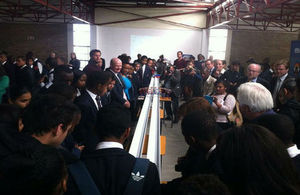British Minister impressed with SA leg of Bloodhound education project
Bloodhound represents UK science and engineering at its visionary best, and is not only inspiring future generations in the UK but in South Africa too.

The British Minister for Science and Universities, Mr David Willetts, on Thursday 12 September 2013 visited a Cape Town school to not only show his support for the engineering and technology behind the building and ultimate racing of the BLOODHOUND supersonic car, but also to the educational drive behind it.
The car is being built in Britain in an attempt to beat the current world land speed record by reaching 1610km/h (1 000 mph) on Hakskeen Pan near Mier in the Northern Cape.
On Thursday, the Bloodhound education team showed the Minister, learners from the Cape Academy for Maths, Science and Technology and other local schools how to build their own paper air rocket vehicles, and how to launch them at dazzling speeds.
“Bloodhound represents UK science and engineering at its visionary best, and is not only inspiring future generations in the UK but in South Africa too,” Mr Willetts said of the world’s first open data project. “Bloodhound helps to show learners from schools such as the Cape Academy of Maths, Science and Technology just how rewarding science and engineering careers can be.”
He expressed the hope that many of the learners would be able to see the BLOODHOUND SSC in action on the salt flats of the Hakskeen Pan in 2015 and 2016 when it is put through its supersonic paces.
According to Mr Dave Rowley, Bloodhound education director in South Africa, more than 33 000 children have already been introduced to the project, with 220 schools already participating. The education project, which is simultaneously run in Britain, inspires young learners through fun ways to become interested in science and maths, and to ultimately consider it as a career choice.
“All the data and videos on the research, design, manufacturing and testing of the car is being shared for free with as many learners, educators, schools, students and members of the public as possible, and therefore we’d like schools to contact us to join and learn from this endeavour,” said Rowley, who hopes to have registered 1000 participating schools by the end of 2014, 300 of which will hopefully be in the Northern Cape.
“Our school fell in love with the Bloodhound project the moment we were introduced to it more than three years ago,” remembers Mr Greg van Schalkwyk, principal of the Cape Academy for Maths, Science and Technology. “Its focus on different materials, fuels and designs has helped to shape our learners’ thinking about the application of many fields of science.”
Ijaaz Sayed is among a group of learners from the school who have been inspired by the Bloodhound project to try their hand at building propelled model cars. He says a talk by his science teacher, Mr Yusuf Sadar, earlier in the year about the Bloodhound project inspired him to start looking for designs on the Internet, and to start dabbling with various combinations of propellants to launch it with.
“It is amazing to think how far engineering and technology has brought us, and how far we can still go if we just work together,” this aspiring pilot said of the impact of science on everyday life.